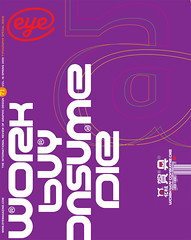Spring 2009
Khoi Vinh
‘The Web is a lost opportunity’
Khoi Vinh is design director for the US newspaper website nytimes.com. He blogs about design, technology and culture on Subtraction.com.
The internet offers no end of possibilities for re-imagining publishing and the role of design, but sadly little in the way of a robust environment for typography. So, if you’re looking for an online archetype of this moment in the art form, there is none. Or, rather, only what is there by default: Georgia (1996), Verdana (1996) and Arial (1982), the typefaces distributed free with Microsoft’s Internet Explorer browser for the past decade.
The net result is the ubiquity of these three faces (two of which were designed by Matthew Carter) and, less benignly, a kind of monopoly on typographic expression. They are everywhere, mostly because designers have few other reliable choices when specifying fonts for a Web site. Whatever you have to say online, chances are it will be expressed through one of these exceedingly few typographic voices.
The fact is, the Web is a lost opportunity for typography as an art form and as a business. By giving away fonts with their software, browser publishers effectively blocked the establishment of any viable market for the sale and distribution of new faces. There is no economic incentive and therefore no opportunity for new type designs to gain traction online. So, all those talented, ambitious Web designers tackling the challenges posed by an wholly new paradigm of publishing have to forge ahead without the benefit of truly functional, expressive typography.
Khoi Vinh, design director, NYTimes.com, The New York Times
First published in Eye no. 71 vol. 18 2009
Eye is the world’s most beautiful and collectable graphic design journal, published quarterly for professional designers, students and anyone interested in critical, informed writing about graphic design and visual culture. It is available from all good design bookshops and online at the Eye shop, where you can buy subscriptions and single issues.

